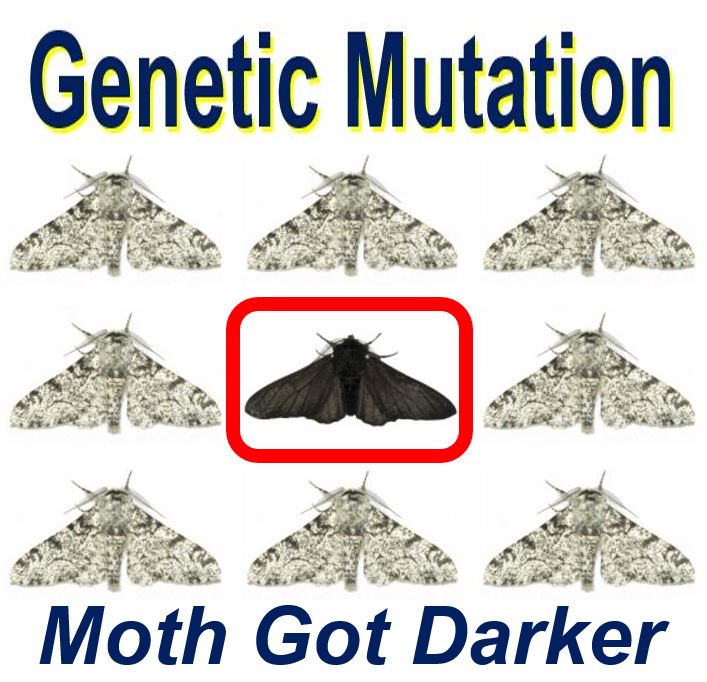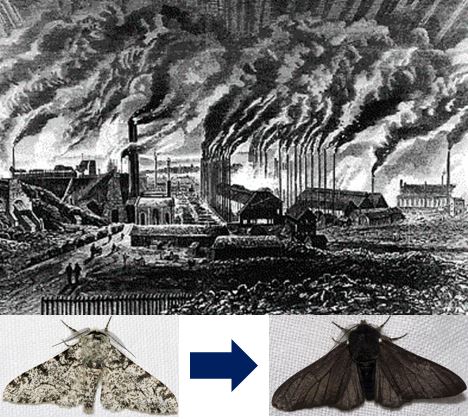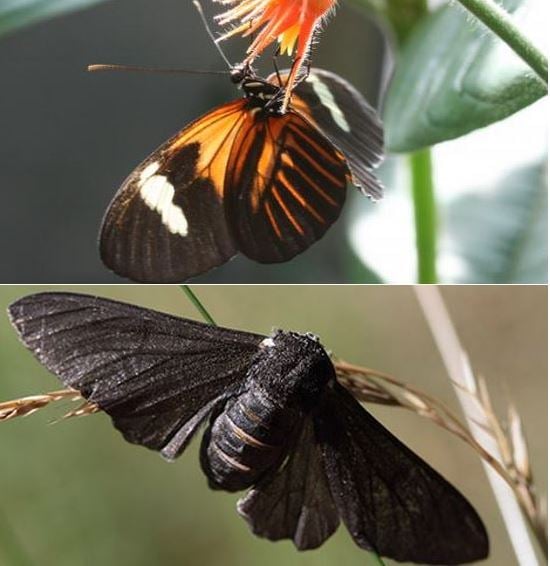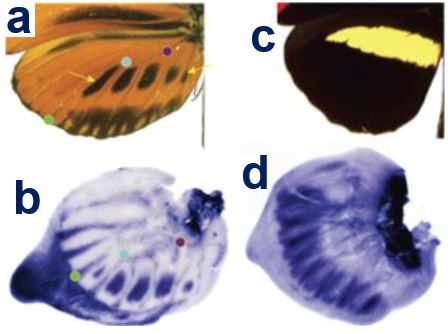The peppered moth developed its dark, black form during the Industrial Revolution – this genetic mutation was an evolutionary camouflage move given that during this period many surfaces were covered in black soot, says a team of scientists from the University of Liverpool and the Wellcome Trust Sanger Institute in Cambridgeshire, both in England.
The researchers – who say they identified and dated the genetic mutation that gave rise to the darker form of the peppered moth – explained in the prestigious journal Nature that their new findings solve a key missing piece of the puzzle of this classic example of evolution by natural selection.
The peppered moth typically has light-coloured wings. However, the dark form displaced the lighter form during the Industrial Revolution, allowing the insect to blend in with the soot-covered bark of urban trees, thus avoiding predation from birds.
 During the Industrial Revolution, the peppered moth (Biston betularia) underwent a genetic mutation which made it darker. This allowed it to blend in better on the darkened surfaces. (Image: liverpool.ec.uk)
During the Industrial Revolution, the peppered moth (Biston betularia) underwent a genetic mutation which made it darker. This allowed it to blend in better on the darkened surfaces. (Image: liverpool.ec.uk)
Study leader, Dr. Ilik Saccheri, from Liverpool University’s Institute of Integrative Biology, and colleagues explain in the journal that they discovered that a ‘jumping gene’ mutation was responsible for this dark variant. Using statistical modelling, this mutation was independently dated to around 1819, which matches the historical record.
Transposable elements (jumping genes)
Transposable elements (TEs), known informally as ‘jumping genes’, are mobile DNA segments that change their position within a genome and change the expression of other genes.
The team used fine-scale linkage and association mapping, combined with next-generation DNA sequencing and established that a large transposable element, inserted within the peppered moth’s cortex gene, was responsible for the change in colour.
 During the Industrial Revolution, coal was widely used to power the industrial machines in Europe. In order to survive and camouflage, the peppered moth changed to the colour of coal to hide from possible predators. (Images: Top – Mr. Leverett’s World History. Bottom Left – Wikipedia. Bottom Right – Wikipedia)
During the Industrial Revolution, coal was widely used to power the industrial machines in Europe. In order to survive and camouflage, the peppered moth changed to the colour of coal to hide from possible predators. (Images: Top – Mr. Leverett’s World History. Bottom Left – Wikipedia. Bottom Right – Wikipedia)
Regarding their latest discovery, Dr. Saccheri said:
“This discovery fills a fundamental gap in the peppered moth story. The fact that this famous mutant is caused by a transposable element will hopefully attract more interest in the impact of mobile DNA on fitness and the generation of novel phenotypes.”
Mutation took 3 decades to be noticed
The first sighting of a black peppered moth that we know about – the first documented sighting – was in 1848 in Manchester, northern England. However, it had probably existed undetected in the moth population at low frequency for several years.
To independently determine when the mutation occurred, the scientists used a simulation-based statistical ‘time machine’ to infer how many generations were needed to arrive at the observed pattern of variation in the DNA sequence flanking the TE.
Co-author, Dr. Pascal Campagne, also from Liverpool’s Institute of Integrative Biology, said:
“Our best estimate of 1819 shows that the mutation event occurred during the industrial revolution and that it took around 30 years for it to become common enough to be noticed.”
 The heliconius butterfly (top) has evolved bright yellow colours to deter predators, while the peppered moth (bottom) famously turned black to hide from birds. Two parallel studies reveal that the same gene causes both, which raises fascinating questions regarding how evolution by natural selection occurs in these insects. (Images: University of Cambridge)
The heliconius butterfly (top) has evolved bright yellow colours to deter predators, while the peppered moth (bottom) famously turned black to hide from birds. Two parallel studies reveal that the same gene causes both, which raises fascinating questions regarding how evolution by natural selection occurs in these insects. (Images: University of Cambridge)
Co-author Dr. Arjen Van ‘T Hof, a Research Assistant in Functional and Comparative Genomics at the Institute of Integrative Biology, said:
“These findings provide an opportunity to further develop peppered moth industrial melanism as a tool for teaching evolutionary biology and the genetic basis of adaptation.”
In an Abstract which describes the main paper in the journal, the scientists wrote:
“Our findings fill a substantial knowledge gap in the iconic example of microevolutionary change, adding a further layer of insight into the mechanism of adaptation in response to natural selection.”
“The discovery that the mutation itself is a transposable element will stimulate further debate about the importance of ‘jumping genes’ as a source of major phenotypic novelty.”
 a, b, H. numata tarapotensis (replicated 3 times in the lab). Adult wing shown in a; coloured points indicate landmarks, yellow arrows highlight adult pattern elements corresponding to cortex staining. c, d, H. melpomene rosina (replicated 3 times in the lab). (Image: nature.com)
a, b, H. numata tarapotensis (replicated 3 times in the lab). Adult wing shown in a; coloured points indicate landmarks, yellow arrows highlight adult pattern elements corresponding to cortex staining. c, d, H. melpomene rosina (replicated 3 times in the lab). (Image: nature.com)
Parallel paper – Butterfly findings
In a parallel paper, also published in Nature, scientists from the Universities of Sheffield and Cambridge, both in England, explained that the same cortex gene also enables tropical butterflies to mimic each other’s colourful patterning.
Regarding the butterfly findings, Dr. Saccheri said:
“This is highly unexpected, both because the butterfly and moth polymorphisms appear very different to the eye, and the species are separated by over 100 million years.”
“What this suggests is that the cortex gene is central to generating pattern diversity across the Lepidoptera, and more generally that adaptive evolution often relies on a conserved toolkit of developmental switches.”
Scientists from both parallel studies say their findings offer clues about how genetics plays a role in making evolution a predictable process. The cortex gene, which helps regulate cell division in moths and butterflies, has become a key target for natural selection acting on the pattern and colour of the wings.
Co-author in the butterfly study, Chris Jiggins, Professor of Evolutionary Biology and a Fellow of St John’s College, University of Cambridge, said:
“What’s exciting is that it turns out to be the same gene in both cases. For the moths, the dark colouration developed because they were trying to hide, but the butterflies use bright colours to advertise their toxicity to predators. It raises the question that given the diversity in butterflies and moths, and the hundreds of genes involved in making a wing, why is it this one every time?”
Dr Nicola Nadeau, an NERC Research Fellow from the University of Sheffield added:
“It’s amazing that the same gene controls such a diversity of different colours and patterns in butterflies and a moth. Our study, together with the findings from the University of Liverpool, shows that the cortex gene is important for colour and pattern evolution in this whole group of insects.”
In an Abstract, the scientists in this parallel study wrote:
“In parallel with findings in the peppered moth (Biston betularia), our results suggest that this mechanism is common within Lepidoptera and that cortex has become a major target for natural selection acting on colour and pattern variation in this group of insects.”
Two Citations:
The Moth Study – “The industrial melanism mutation in British peppered moths is a transposable element,” Jessica Lingley, Michael A. Quail, Neil Hall, Arjen E. van’t Hof, Pascal Campagne, Daniel J. Rigden, Carl J. Yung, Alistair C. Darby and Ilik J. Saccheri. Nature 534, 102–105. 2 June 2016. DOI: 10.1038/nature17951.
The Butterfly Study –“The gene cortex controls mimicry and crypsis in butterflies and moths,” Richard H. ffrench-Constant, Violaine Llaurens, Mathieu Joron, Nicola J. Nadeau, Carolina Pardo-Diaz, Annabel Whibley, Megan A. Supple, Suzanne V. Saenko, Richard W. R. Wallbank, Grace C. Wu, Heather Hines, Camilo Salazar, Luana Maroja, Laura Ferguson, Joseph J. Hanly, Richard M. Merrill, Andrea J. Dowling, W. Owen McMillan and Chris D. Jiggins. Nature 534, 106–110. 2 June 2016. DOI: 10.1038/nature17961.
Video – Peppered moth mystery solved
Scientists now know how the peppered moth changed colour during the industrial revolution.
